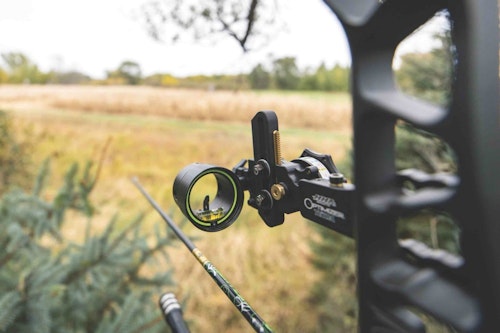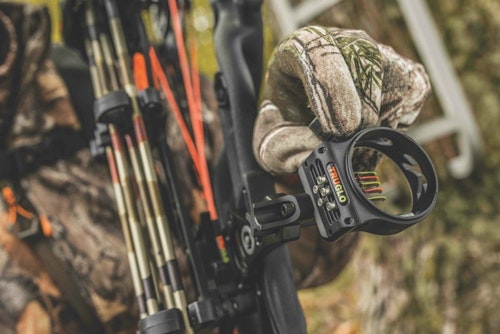Bowsights are like ice cream flavors. Have you ever tried a new flavor and then wished you’d ordered your usual? On the contrary, have you ever tried an unusual flavor and been floored? Your customers face a similar situation when they visit your store to shop for bowsights. If they deviate from what they know, it could be the best or worst decision they’ve ever made.
The difference between my ice cream analogy a bowsight is that a two-scoop waffle cone costs approximately $4 to $7, and a bowsight is likely at least $100. In other words, you can’t afford to let your customers make the wrong choice. As a sales associate, you must help them navigate through this difficult decision.
In this article, I’ll compare the pros and cons of two basic bowsight styles, single-pin and multi-pin. Ultimately, the breakdown will help you pair each customer with a bowsight they’ll love — one that meets their needs. Your efforts will yield happier customers who shoot better. Follow along!
Single-Pin Pros and Cons
A single-pin sight’s undeniable advantage is an uncluttered sight picture that doesn’t obstruct the target. When faced with an extraordinary shot opportunity, having only one pin within the sight aperture also substantially simplifies aiming; there is no fear of using the incorrect pin in the heat of the moment. This is a true positive for newer archers, those with waning vision, or those who struggle to think objectively under pressure.
Another benefit most single-pin sights provide is to-the-yard adjustability via a slider or drive system. Rather than hold one pin high or another low, simply adjust the pin to the exact yardage and then aim dead on — there’s no compensating.
Some might consider a single-pin sight ineffective for scenarios where an animal walks several steps toward or away once the bowhunter reaches full draw. In other words, you cannot re-adjust the sight without first letting down. Let’s consider a couple points regarding the said situation.
First, if the animal is within top-pin range, a few steps will usually affect arrow impact only minimally, particularly with today’s flat-shooting bows. Of course, an animal 40 yards out that takes several steps in either direction becomes another matter entirely; letting down, re-ranging, and re-adjusting the sight are the ethical moves. However, this requires additional time and movement, which could alert the animal and cost you the shot opportunity.
Most single-pin sights feature a smaller scope diameter than the average multi-pin sight. This constricts light transmission, which makes dawn and dusk shot opportunities more difficult to pull off. On the flip side, a smaller scope is nice and compact, reducing weight and bulk.
One last negative point about single-pin slider sights is when you adjust for varying yardages, you’ll have to change your anchor point slightly to center your sight ring in your peep sight. Most people don’t realize this. But, if you slide from 20 yards to 60 yards, the scope moves vertically, and you’ll measurably change your anchor point to center your sight ring in the peep.
Multi-Pin Pros and Cons
Commercially sold multi-pin sights date back to threaded brass posts tightened to a metal bracket with tips painted different colors for easy yardage reference. In fact, I used one of these on my first legitimate compound bow, which was a 1990s XI Omega Explorer. My point is multi-pin sights have been field-proven for decades and decades.
The No. 1 advantage to a multi-pin sight is the bowhunter can range the animal, then draw back and shoot — no adjustments requiring additional time and movement are needed. In hunting applications where now-or-never shots are typical, multi-pin sights can help you shoot more quickly.
Understand, though, that every coin has two sides. In this case, it could be that the bowhunter rushes the shot because they can. A single-pin sight causes you to slow down and think everything through more objectively. A multi-pin sight is ready to roll as soon as your rangefinder provides a reading.
Multiple pins inside a scope can clutter your sight picture. In dusky lighting, the additional pins can obstruct the animal, thus impeding the bowhunter’s ability to positively distinguish the animal’s bodily features required for precise aiming. Further, the clutter can also inflict confusion during the moment of truth. Trying to choose the correct pin to aim respective of yardage can create a sudden panic attack, instilling the notion that you must hurry up, figure out which pin is correct and punch the trigger the millisecond it lands near the vitals.
One manufacturer has bridged the gap between single- and multi-pin sights to solve this dilemma. Option Archery has a magnetized scope with multiple pins that attaches to a second magnetized scope with a single movable pin. If the shooter wants the benefits of a multi-pin sight, he or she can shoot the sight with both scopes perpendicular. If the shooter wishes to declutter the sight picture and shoot a single adjustable pin, they can instantly swing away the multi-pin housing and use the single-pin scope. It’s remarkable and proven technology.
Another type of hybrid multi-pin sight worth noting exists. Many manufacturers offer multi-pin sights that also have a slide or drive features. Let’s suppose the bowsight has three fixed pins set for 20, 30 and 40 yards. You get the benefits of multiple pins for shots out to 40 yards, but you also have the option to adjust with to-the-yard accuracy on shots beyond 40 yards. This is my sight type of choice.
Like the single-pin movable sight, a multi-pin mover also will cause you to adjust your anchor point to center your sight ring inside your peep sight. I’ve been shooting this type of sight long enough that it has become natural, but it will throw a curveball to newer archers or those who’re accustomed to conventional fixed-pin sights.
Match Your Customer With the Correct Bowsight
Now that we’ve broken down the essential functions of both single- and multi-pin sights, along with several pros and cons, let’s discuss the selling points you can use with your customers to help them choose sights that meet their individual needs and preferences.
First, determining skill level is critical. Newer archers often shoot best with a single-pin sight. They have enough to remember without trying to choose the correct pin at full draw. Plus, taking and making odd-yardage shots with a fixed multi-pin sight requires knowledge and skill, which they likely haven’t yet developed. A single-pin movable sight allows them to adjust the pin to the exact yardage and aim dead on. It simplifies the entire shot procedure.
Next, ask what type of hunting your prospect does and in what kinds of settings. As we discussed earlier, locations where now-or-never shots are reasonable are conducive to a multi-pin sight. For example, a deep woods treestand with narrow shooting lanes will often require fast shooting. Adjusting a single-pin sight could gamble the shot opportunity away.
In contrast, perhaps your client hunts pronghorn on the wide-open prairies where longer shots are expected. The ability to dial a single-pin sight to an exact distance is clearly advantageous.
Personal needs and preferences are obviously important to determine. Does your prospect have blurry or fuzzy vision? If so, a cluster of brightly colored pins will likely worsen the aiming process. In contrast, a single upright pin, centered in the scope, provides a clearer sight picture, thereby allowing precise aiming.
These are some starting points to help your customer think through their purchase rather than grab the first bowsight that catches their eyes. Feel free to expand from here and ask more questions until you have no doubt which sight best fits their individual needs.
Final Thoughts
There are dozens of different bowsights on the market. Just like walking into an ice cream parlor that offers 50 different flavors, your customers face a difficult decision whenever they prepare to purchase a new sight. And there isn’t a one-size-fits-all solution.
What works well for an expert bowhunter who hunts in the big timber where shots happen fast probably isn’t the best choice for a new bowhunter who’s sitting over a 25-yard-across food plot. Rather than suggest the same bowsight for every bowhunting customer who enters your store, take steps to learn their preferences, hunting styles and applications before you sell them a new sight. You’ll gain a lot of respect and repeat business because most customers will be happier with their selection. When you sell your customer the correct bowsight, everyone wins.
Sidebar: Quick-Reference Sell Sheet
Single-Pin
- Uncluttered sight picture
- To-the-yard adjustability and aiming; no bracketing for odd-distance shots
- Confusion-free pin selection
- Beginner-friendly functionality
Multi-Pin
- Range and shoot without adjusting; no additional time or movement required
- Larger scope allows better light transmission
- Fewer moving parts
- Anchor-point change not required since scope remains stationary
Multi-Pin Movable
- Get fixed-pin convenience out to bottom fixed pin with the ability to adjust to the yard for longer distance
- Larger scope allows better light transmission
- Practice shooting at double your maximum hunting distance









